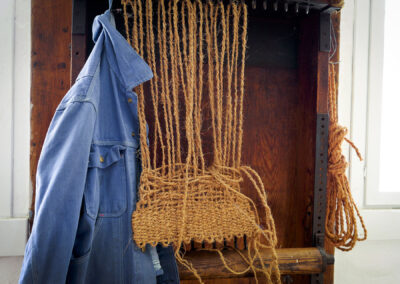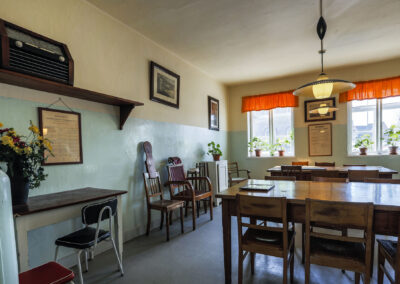About the Poor House
The Poor House was in operation from 1872 to 1974
The Poor House in Svendborg was built in 1872 under the name “Svendborg Kiøbstads Poor- and Workhouse”. It was a modern institution for its time, designed for those who were deemed ’worthy or unworthy’ paupers.
Behind the walls
Behind barbed wire and high walls, you embark on a journey through an important part of the history of Danish welfare. We open the doors to an otherwise closed world. Within the authentic setting, you will explore the stories of the many who lived or live on the dark side of society: the poor, the sick, the homeless and the orphans.
Explore where the paupers worked, ate, slept, were washed and punished. Many rooms are still as intact as when the poorhouse closed in 1974.
Plan your visit
What does it cost? Where can we park? Can we bring packed lunches? Find the answers on this page.
Opening hours
Opening Hours 2024
6. February – 15. December 2024
Tuesday – Sunday 10 am-4 pm
Week 7, 27-32 & 42
Monday – Sunday 10 am-4 pm
The Danish Welfare Museum does not receive guests in January. Here, we maintain the buildings and exhibitions. The booking phone is still open.
Admission
Admission 2024
| Adult | 95 DKK |
| Student | 75 DKK |
| Children (0-17 years) | Free |
Group discount
For groups of minimum 10 paying guests, the price is 80 DKK per person.
The group discount cannot be combined with other discounts.
We ask you to contact us in advance if you are more than 10 people. This applies both if you come on your own or if you want a guided tour. That way, we ensure that you will have the best experience.
Free admission
It is important for the museum that everyone has the opportunity to visit the museum. Therefore, there is free admission on the first Sunday of the month. Groups of more than 10 people must pay entrance fees.
Bus drivers and any tour guides visiting the museum with a larger group have free admission.
Contact the museum
Our general inbox and phones are monitored Monday-Friday, 10:00 a.m.–2:00 p.m.
Find your way
Grubbemøllevej 13, DK-5700 Svendborg

By train, bus, car, or boat?
The Danish Welfare Museum is located in the center of Svendborg and a 10-minute walk from the train and bus station.
Take the train from Odense to Svendborg. It takes less than an hour. Take the bus from Rudkøbing and Nyborg to Svendborg. It takes just under an hour. Check the travel plan.
Drive on the highway from Odense to Svendborg. You will find a link to parking lots and charging stations under Parking.
Take the boat to Svendborg and moor in the marina or take the ferry from Ærø. Check Svendborg Harbour and the schedule for the Ærø Ferry.
Parking
Cars can park in front of the museum – remember the parking disc.
In front of the museum entrance, there is one parking space reserved for disabled parking.
Duration of visit
Allow plenty of time for a visit to the museum. Most guests spend a minimum of two hours in the exhibitions and the Museum Garden.
Age considerations
It can be a powerful experience for younger children to visit the museum. Therefore, we recommend that children be accompanied by an adult and have a certain age – preferably from 6 years old.
Food and drink
You can buy cold and hot drinks, ice cream, chocolate, and candy.
Unfortunately, we do not sell sandwiches, cakes, or bread.
You are welcome to bring your own food and drinks.
Museum Shop
The museum has a shop with a fine selection of goods produced with a focus on social responsibility.
You’ll also find unique items with connection to the Poorhouse. You can purchase mats woven in the mat workshop by the museum’s volunteers, and cuttings of the original geraniums at the Poorhouse.
Please note that some items may be sold out.
The shop has the same opening hours as the museum. You can always visit the shop without buying a museum ticket.
Accessibility
In front of the museum entrance, there is one parking space reserved for disabled parking.
The museum is housed in the original buildings that were the Poor House from 1872-1974. At the museum, we prioritize giving everyone the best opportunities to move around the site. The museum was renovated in 2009 and most areas made wheelchair accessible.
The access conditions are good between the two buildings with exhibitions and ticket sales. Elevator in both buildings enables access to the exhibitions on the 1st floor. It is possible to get around with a wheelchair and walker in most rooms on the ground floor and on the 1st floor.
There is step-free access with door automation in the two exhibition buildings. Toilets for people with disabilities are located in the ticket sales and the two buildings.
Unfortunately, there is no elevator to the top floor, where the exhibition “Seven Poor Children” is shown. This made the preservation of the buildings impossible.
Dogs
Guide dogs, service dogs, and other dogs are welcome at the museum. They just need to be on a leash, and consideration should be taken for other guests.
Smoking
Smoking is allowed in the museum’s outdoor areas in designated areas.
PLACED IN CARE
The exhibition opened on June 24, 2023, and is the museum’s new permanent exhibition.
The exhibition is divided into two sections – one for youth/adults and one for children aged 8-12.
In the exhibitions the museum shares stories about children who have been placed in care. The exhibitions focuses on a time period that spans from the 19th century till today.
How we work and why?
The mission of the Danish Welfare Museum is to preserve cultural heritage and create social history about, with, and for former placed-out or socially vulnerable citizens.
Through a museum activist approach, we connect past experiences with the present.



